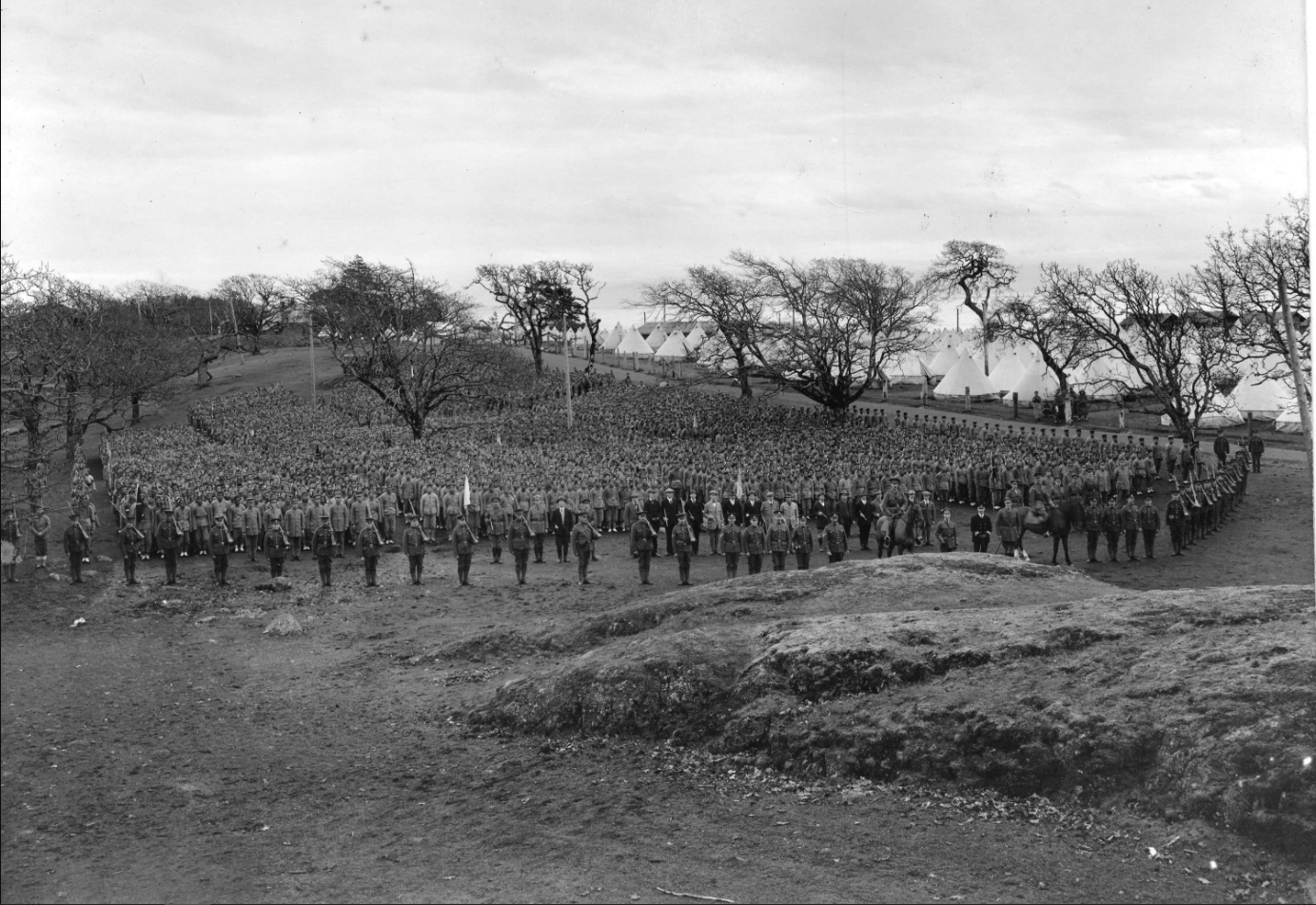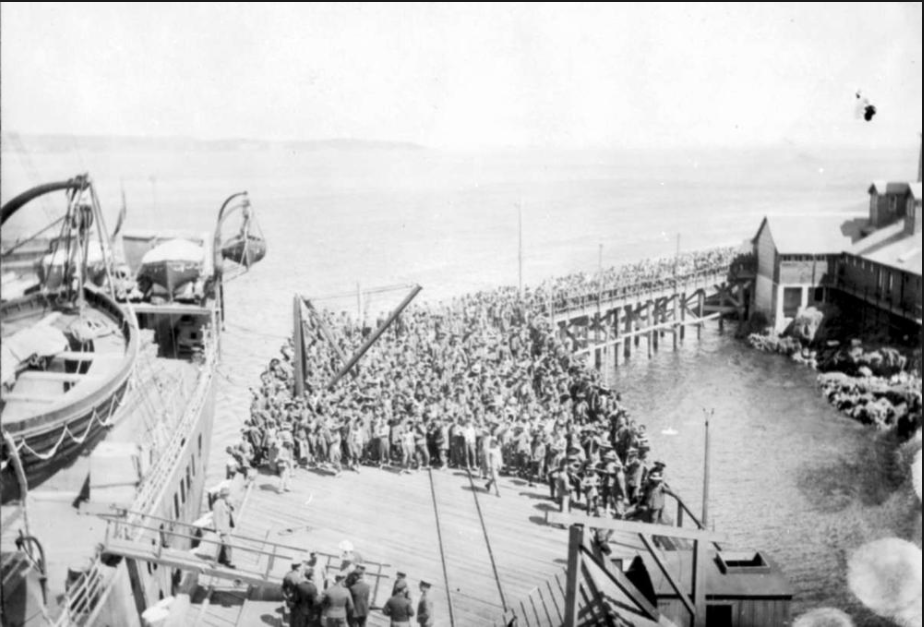Robert Ashton kindly sent me this photo of hundreds of Chinese men standing on a hill with rows and rows of white army bell tents in the background.

He also found a 1920 copy of Pacific Marine Review with this story.
“During the last five months, almost 50,000 Chinese coolies have passed through the port of Vancouver on their way from work in the European war zone back to their homes in China. At times the congestion at the Williamshead quarantine station has been very great. For instance, at the end of the second week in March there were over 8000 coolies housed at that point. On March 14 the steamer Ixion sailed with 3625 of these Chinamen and during the same week the steamer M.S. Dollar took 4300 and the Bessie Dollar took those remaining or about 1400. As the steamship companies got $55 each for transporting the men across the Pacific, it can readily be seen that these vessels will net a nice little sum out of this work.”
Robert wanted to know if anyone knew where the photo was taken. And, so did I.

William Head, it turns out, is in Metchosin, just outside of Victoria. It was a quarantine station from 1872 to 1959 designed to stop the spread of smallpox, leprosy and meningitis. The station was equipped to handle 800 people in a 42-building, 106-acre facility.
Between 1917 and 1920 more than 84,000 Chinese were held there in quarantine.
The men were part of the Chinese Labour Corps, a secret division formed under the British Army during the First World War. More than 90,000 “volunteer” workers from China and Mongolia were told that they were being recruited to work as labourers in non-combative roles.
The Chinese boarded ships in eastern China, crossed the pacific and were quarantined at William Head. After a brief stay they were put on guarded trains and taken to the east coast where they sailed to France.
According to author, Peter Johnson* when the Chinese landed at Dunkirk they were fired at, gassed and thrown into whatever war-time horrors were happening on any given day.
The former quarantine station and some of the buildings were incorporated into the William Head Institution—a minimum-security prison that opened in 1959 and houses 180 inmates.
*Peter Johnson is the author of Quarantined: Life and Death at William Head Station: 1872-1959, Heritage House Publishing, 2013.
© All rights reserved. Unless otherwise indicated, all blog content copyright Eve Lazarus.



13 comments on “The Chinese Labour Corps: One of BC’s Best Kept Secrets”
Until about 30 years ago, there was an empty brick building several stories high, located on the landward side of Dallas Road just before the turn off for the Fishermans Wharf which was used as a holding pen by Immigration for Chinese persons coming to Victoria from China. It was much older than Williams Head, and in construction style was very similar to the Victorian brick construction in downtown Victoria…By the time I was in Victoria, about 1970 or so, it was vacant but boarded up, and no one involved in Heritage there had access, since it was owed by the Federal Government. Although William Head may have been used as your information suggests, if this was happening around 1914 -1918 then the immigration facility on Dallas Road might also have been used…
The first picture in this article looks much more like the Dallas Road area in downtown Victoria..Beacon Hill Park area, and surroundings than at William Head. Mind you I have only seen William Head in its current guise as a Correctional Facility, but the sweep of shoreline and trees in the first picture looks much more like the area closer to the City.
That’s really interesting, I’ll have to do some digging and find out if any photos exist of the Dallas Road building. I’ve found a few different versions of this photo and they all say William Head, but there was some fearful overcrowding, so perhaps other sites were used. Here’s the link to the photo: it’s worth taking a look at in high res http://searcharchives.vancouver.ca/chinese-labour-battalion-at-william-head-quarantine-station-en-route-to-france
Ahhh… Dallas Road and William Head were different federal facilities. The latter was not about immigration during WW I. The photo you refer to was taken near Metchosin, not Victoria. So why the speculation?
I have got in touch by email this morning, with some Victoria friends involved in Heritage, and asked about the Dallas Road building. There is a very strong group people who know about the Chinese history there, who should be able to tell us something more about the “Immigration” building.
If I get information back, I will post it.
That would be great, thank you.
Very interesting, in a sad way.
[…] Lazarus takes a look at the Chinese Labour Corp, a “secret division” of the British Army in WW1. After being “voluntold,” these men were brought from China to William Head (outside Victoria), […]
Great piece. The transportation of the Chinese workers across Canada was done in secret, as was the transportation from Liverpool to Folkestone once they arrived in England. Although news of tens of thousands of Chinese travelling across Canada was completely censored the Chinese Labour Corps was not itself a secret, it’s formation being announced in the Times of London in 1916.
The reason for this secret transportation is not absolutely clear. However, the Germans were well aware of the recruitment of Chinese for working on the Western Front, they had pickets outside the recruitment centre at Weihai Wei, in Northeast China. The only thing we do know for certain is that it was a condition set by the Canadian government.
Fear of the “Yellow Peril” was at its height, and Canada had intruded a $500 head tax that was required from any Chinese entering Canada. $500 was about the total amount a labourer might expect to earn over two years. In common with The USA, South Africa, Australia and the UK, the Chinese were not welcome in Canada.
Most probably the secrecy was to pre-emt the possibility of Chinese signing up to the Chinese Labour Corps as a means to enter Canada, where, had they been so inclined, they could have slipped into the Canadian countryside as the train trundled for six days – at least they might have been able to had the carriages not be locked and under armed guard to stop such escapes.
Steve Lau
Chair
http://nsuringWeRemember.org.uk
Steve, thanks so much for sharing this website: http://ensuringweremember.org.uk/ and adding to the story. Also Victoria-based author Peter Johnson has written a book called Quarantined: Life and Death at William Head Station: 1872-1959, Heritage House Publishing, 2013. I haven’t read this yet, but I’m sure it clears up a lot of these questions.
Please can you correct the website address in the comment I just submitted. The correct address has an E, as shown below.
OK, try again as the webs address wasn’t shown the second time! Sorry.
Please can you correct the website address in the comment I just submitted. The correct address has an E, i.e.:
http://EnsuringWeRemember.org.uk
As a child growing up in Victoria I can remember looking at the old Immigration building when our family went out on our Sunday drives around the waterfront. Back then, in it’s abandoned state, it seemed like a prison to me, certainly not welcoming. My parents told me that it had been used as an immigration building for new arrivals from countries where certain diseases were common. They said that immigrants were held there until checked by medical staff. It’s quite possible my father, who interned in Victoria in the late 30’s, might have worked there periodically as part of his training. My mother, a hospital lab technician, told me about the lab tests etc. but I’ve long forgotten the details.
You probably should have a look at Dan Black’s “Harry Livingstone’s Forgotten Men: Canadians and
the Chinese Labour Corps in the First World War”. Toronto: James
Lorimer & Company, 2019. Pp. 504.
Here’s a book review for the “Cole’s Notes” of the book:
https://scholars.wlu.ca/cgi/viewcontent.cgi?article=2054&context=cmh